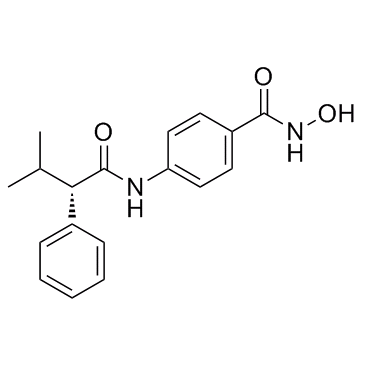AR-42
Modify Date: 2025-08-25 19:50:06

AR-42 structure
|
Common Name | AR-42 | ||
|---|---|---|---|---|
| CAS Number | 935881-37-1 | Molecular Weight | 312.36300 | |
| Density | 1.223 | Boiling Point | N/A | |
| Molecular Formula | C18H20N2O3 | Melting Point | N/A | |
| MSDS | N/A | Flash Point | N/A | |
Use of AR-42AR-42(HDAC-42) is a HDAC inhibitor with IC50 30 nM.IC50 Value: 30 nMTarget: HDACin vivo: HDAC42 is potent in suppressing the proliferation of U87MG and PC-3 cells, in part, because of its ability to down-regulate Akt signaling. AR-42 inhibits the growth of PC-3 and LNCaP cells with IC50 of 0.48 μM and 0.3 μM, respectively. Compared to SAHA, AR-42 exhibits distinctly superior apoptogenic potency, and causes markedly greater decreases in phospho-Akt, Bcl-xL, and survivin in PC-3 cells. AR-42 treatment induces growth inhibition, cell- cycle arrest, apoptosis, and activation of caspases-3/7 in malignant mast cell lines. AR-42 treatment induces down-regulation of Kit via inhibition of Kit transcription, disassociation between Kit and heat shock protein 90 (HSP90), and up-regulation of HSP70. AR-42 treatment down-regulates the expression of p-Akt, total Akt, phosphorylated STAT3/5 (pSTAT3/5), and total STAT3/5. in vitro: In the transgenic adenocarcinoma of the mouse prostate (TRAMP) model, administration of AR-42 not only decreases the severity of prostatic intraepithelial neoplasia (PIN) and completely prevents its progression to poorly differentiated carcinoma, but also shifts tumorigenesis to a more differentiated phenotype, suppressing absolute and relative urogenital tract weights by 86% and 85%, respectively. AR-42 significantly reduces leukocyte counts, and prolongs survival in three separate mouse models of B-cell malignancy without evidence of toxicity. |
| Name | N-hydroxy-4-[[(2S)-3-methyl-2-phenylbutanoyl]amino]benzamide |
|---|---|
| Synonym | More Synonyms |
| Description | AR-42(HDAC-42) is a HDAC inhibitor with IC50 30 nM.IC50 Value: 30 nMTarget: HDACin vivo: HDAC42 is potent in suppressing the proliferation of U87MG and PC-3 cells, in part, because of its ability to down-regulate Akt signaling. AR-42 inhibits the growth of PC-3 and LNCaP cells with IC50 of 0.48 μM and 0.3 μM, respectively. Compared to SAHA, AR-42 exhibits distinctly superior apoptogenic potency, and causes markedly greater decreases in phospho-Akt, Bcl-xL, and survivin in PC-3 cells. AR-42 treatment induces growth inhibition, cell- cycle arrest, apoptosis, and activation of caspases-3/7 in malignant mast cell lines. AR-42 treatment induces down-regulation of Kit via inhibition of Kit transcription, disassociation between Kit and heat shock protein 90 (HSP90), and up-regulation of HSP70. AR-42 treatment down-regulates the expression of p-Akt, total Akt, phosphorylated STAT3/5 (pSTAT3/5), and total STAT3/5. in vitro: In the transgenic adenocarcinoma of the mouse prostate (TRAMP) model, administration of AR-42 not only decreases the severity of prostatic intraepithelial neoplasia (PIN) and completely prevents its progression to poorly differentiated carcinoma, but also shifts tumorigenesis to a more differentiated phenotype, suppressing absolute and relative urogenital tract weights by 86% and 85%, respectively. AR-42 significantly reduces leukocyte counts, and prolongs survival in three separate mouse models of B-cell malignancy without evidence of toxicity. |
|---|---|
| Related Catalog | |
| References |
| Density | 1.223 |
|---|---|
| Molecular Formula | C18H20N2O3 |
| Molecular Weight | 312.36300 |
| Exact Mass | 312.14700 |
| PSA | 78.43000 |
| LogP | 3.64780 |
| Storage condition | -20℃ |
| HS Code | 2924299090 |
|---|
| HS Code | 2924299090 |
|---|---|
| Summary | 2924299090. other cyclic amides (including cyclic carbamates) and their derivatives; salts thereof. VAT:17.0%. Tax rebate rate:13.0%. . MFN tariff:6.5%. General tariff:30.0% |
| hdac-42 |
| ar 42 |
| osu-hdac42 |
| AR-42 |